This is part two of a three part series on our son Harrison’s journey with Epilepsy (read Part One HERE). At this point daily seizures have become the norm. And rather than tracking every seizure, we progressed to marking down good versus bad days.
Navigating Epilepsy
In the next few months, Harrison’s seizures continued to get worse.
For medications, we maxed out Topamax, added in Keppra, and considered adding Depakote.
We completed three rounds of genetic testing. The first two came back with no abnormalities. We headed to our next in-person appointment with his neurologist at Minnesota Children’s Hospital. This involved an inpatient stay for extended monitoring of Harrison’s seizure activity.
The Longest Hospital Stay Yet
Within the first 24 hours, the neurologist identified three different seizure types:
- Myoclonic Jerks (body twitches)
- Astatic, or “drop” seizures (sudden loss of muscle tone, resulting in the head or body suddenly dropping)
- Absence (looks like zoning out, non-responsive, lasts 5-15 seconds)
His doctor then advised we stay another night for monitoring and increased his Keppra to the maximum dosage. We agreed, and anxiously waited for our next steps.
Before checking into the hospital, Harrison had only had two drop seizures ever, and was averaging 5-10 total seizures a day (in the form of myoclonic jerks). With the stress of the EEG monitoring, interrupted sleep, and increase/addition of meds, he was up to 30-50 seizures per day by his second day in the hospital. 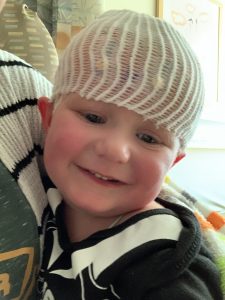
A Diagnosis No Parents Wants to Hear
The next day, the genetic test results showed that Harrison had a mutation in the SCN9A gene. While this wasn’t an exact match to any other known genetic causes of Epilepsy, it is in the same family as SCN1A, which is commonly linked with Dravet syndrome.
Dravet syndrome is a severe form of intractable epilepsy. It does not respond well to medication, and often gets worse over time. Given Harrison’s gene mutation, clinical presentation, and history, the doctor diagnosed him with Dravet.
I encountered this diagnosis in my own research, and was numb when I heard it.
We agreed to stay at the hospital over the weekend. And the extra days allowed us to try a new medication, Depakote. We scheduled an MRI for Monday morning to see if there was any indication of brain damage that could be causing the seizures.
By the end of the weekend, he was having 20-50 seizures a day. His medication load had increased with maximum doses of Topamax, Keppra, and Depakote. And adding in Carnitine to help offset potential harm to his liver from the Depakote.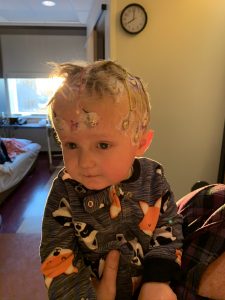
He then continued having 5-20 seizures a day for the next few months, with a drastic increase in drop seizures.
One time he hit his face on the floor at the hospital, resulting in a nosebleed. We left with a prescription for a helmet, which he would wear non-stop for the next year and a half.
The medications also made him incredibly sleepy. And he began to require two to three naps a day. We continued to adjust medication levels, trying to find the right combination for quality of life and reduction in seizure frequency.
Living with Daily Seizures
As the daily seizures became a part of our everyday life, we continued to accommodate Harrison and the effects of the seizures. His drop seizures were so severe that we could not set him down without his helmet for even a second.
On one occasion, he ended up splitting open his chin, resulting in an ER visit and stitches. This injury opened back up multiple times, required multiple trips to the ER, and eventually resulted in a large scar on his chin.
We eventually changed to a helmet with a full face shield to protect his face. Unfortunately, the face shield would scratch easily and overheat Harrison. We then decided on a child-sized hockey helmet. It provided protection, didn’t scratch, and he looked like a cute little hockey fan.
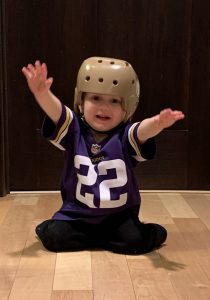
Another challenge was how to keep him safe at daycare. It was requiring more one-on-one attention than a traditional daycare could provide, so we began to search for an alternative.
I was working part-time, and taking Harrison to therapy and doctor appointments when I wasn’t working. We wanted him to get one-on-one care that would keep him safe and help him make improvements regarding his therapy.
In addition to Epilepsy, Harrison also has Cerebral Palsy, which makes it harder for him to perform everyday tasks.
Fortunately he qualified to have an in-home caregiver. And he began to make improvements developmentally, but we continued to struggle to gain control of his seizures.
By the fall of 2020, we had tried and failed five medications. One medication in particular, Topamax, was maxed out with no additional improvements. After realizing how far his speech had regressed, we weaned off Topamax and quickly saw an increase in speech.
It became apparent to us that the medication side effects were negatively impacting his development. With approval from his neurologist, we gradually weaned him down until he was only on one medication (an FDA-approved CBD called Epidiolex). It didn’t have any negative side effects, and he seemed to have cognitive gains after beginning it.
After reducing the other medications we noticed improved balance, a decrease in drowsiness, and overall a brighter, more alert little boy.
Surgical Consult
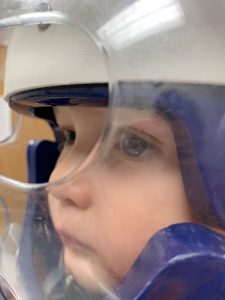
Unfortunately, the COVID-19 pandemic caused delayed appointments and delayed improvements regarding seizure control. Harrison’s doctor had brought up surgery, and initially we were shocked and terrified.
Brain surgery — on our baby?!
I then dove into research on the suggested surgery, corpus callosotomy, to learn everything I could.
It seemed to be a logical next step. It had the potential to greatly reduce the severity and number of drop seizures, sometimes even eliminating them. We agreed to meet with the surgeon. And we anxiously awaited for that surgical consult.
Unfortunately, in that time the seizures continued to worsen.
Harrison’s doctor strongly urged us to try another new medication while we waited to meet with the surgeon. She stressed the importance of reducing the seizure activity. The more seizures the brain has, the more it learns the pathway of misfiring. Continued daily seizures could potentially cause his brain to interpret that misfiring is the “right” way to work, and it will not remember how to function properly. There was also the potential of severe brain damage due to the continued seizure activity. And also an increased risk of SUDEP (sudden unexplained death in epilepsy).
Another Epilepsy Medication
In desperation, we reluctantly agreed to try the most dangerous drug yet — Onfi. I had heard of many negative reactions, but our doctor had several patients who had greatly improved with the medication, so we gave it a try.
Within a couple of days, Harrison’s seizures increased dramatically. He began to have what we described as a “tic,” his body would jerk randomly hundreds of times each day.
He began to lose the ability to feed himself, sit up on his own, crawl, and play with his toys. His quality of life had deteriorated to the point he could only sit on the couch, watching TV or reading books all day.
We weaned off the Onfi within the first week, but the damage caused by the medication was already done. The next few weeks were a nightmare of rescue medications that worked initially, and then stopped having an effect on him. We watched our once vibrant and thriving boy reduced to lying around all day. 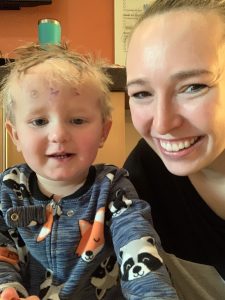
Next Step: Surgery
The day of the surgical consult, we were incredibly nervous, but held on to some hope that this could be the answer. We knew the medications had terrible side effects. And that after failing this many meds, the odds of a new one working were very low.
But if the surgery worked, his brain could get the relief it needed to heal. It could learn how to work without misfiring.
He had the potential to live a life without medications and without seizures. We had to try.
The moment the doctor walked into the exam room, Harrison reached out his arms wanting to give him a hug. My heart almost exploded when the surgeon picked him up, and Harry immediately kissed him on the cheek.
This had to be a sign that this was the right course. We felt very comfortable speaking with the surgeon, and came up with a surgical plan. We were optimistic this would be successful in helping reduce his seizures.
During that brief appointment, he had over 200 seizures. I could see the pain in the eyes of the medical team as our poor boy twitched and jerked uncontrollably. His surgery was scheduled for the next week, and we left with a sense of anxious anticipation.
To be continued in Navigating Epilepsy Part 3: Medication Is Not the Only Answer.
















